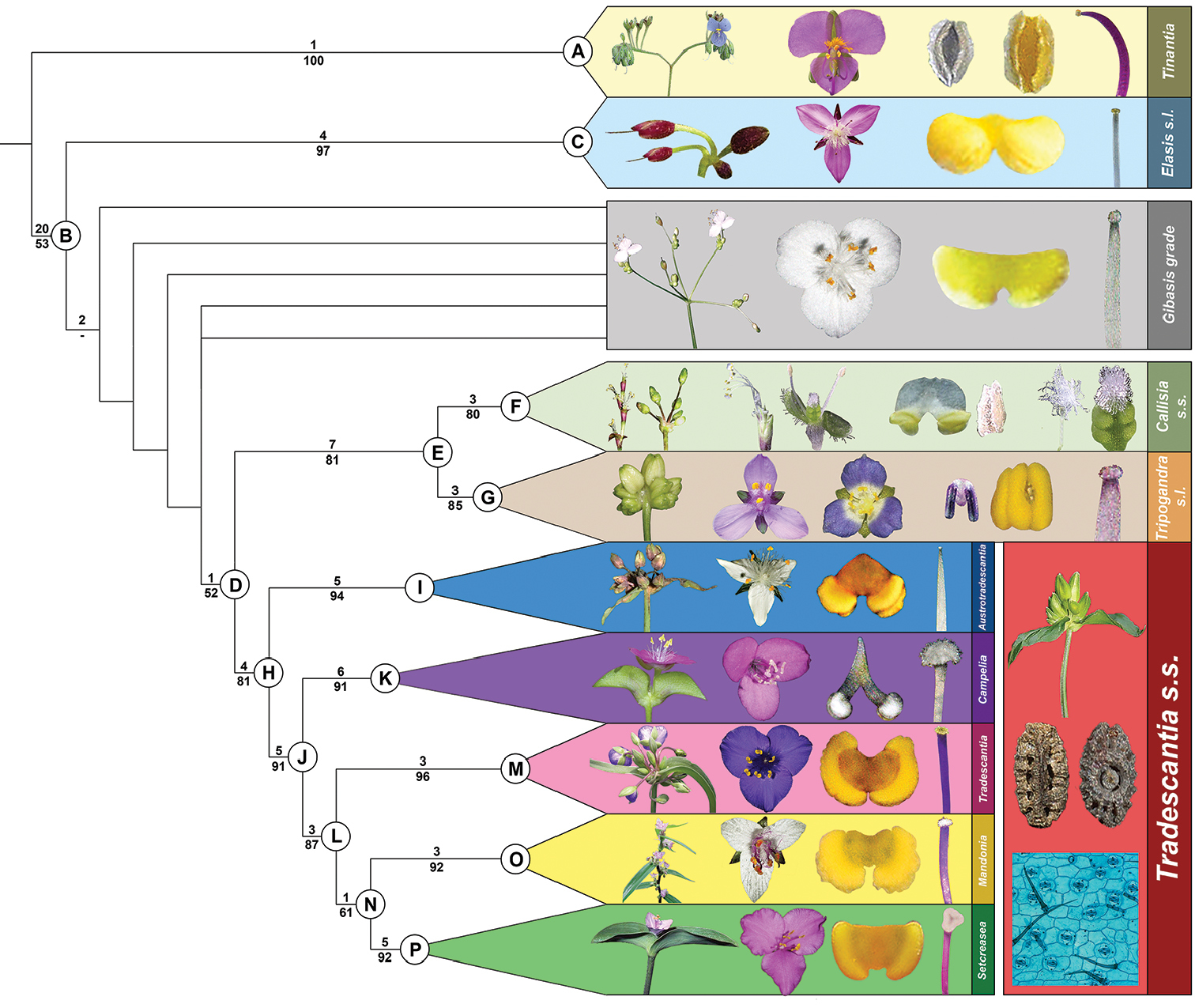
|
||
|
Majority-rule tree showing the relation between the genera in the Tradescantia alliance, highlighting the reproductive synapomorphies recovered for each lineage. Synapomorphies for Tinantia (clade A): cincinni verticillate, flowers zygomorphic, filaments sigmoid, anthers dimorphic with inconspicuous connectives, style sigmoid, stigma truncate, and hilum C-shaped. Synapomorphy for clade B: basal bract inconspicuous and tubular. Synapomorphies for Elasiss.l. (clade C): cincinni fasciculate, flowers actinomorphic, filaments sigmoid, anthers dimorphic, style sigmoid, and stigma truncate. Synapomorphies for clade D: double-cincinni fused back to back. Synapomorphies for clade E: seeds triangular to round triangular or tetrahedral, ventrally ridged, hilum elliptic or punctate, and leaf epidermis with silica crystals in specialized cells with thickened cell walls. Synapomorphies for Callisias.s. (clade F): inflorescences mainly axillary, bracteoles conspicuous, pedicels apically non-gibbous, and penicilliform stigma. Synapomorphies for Tripogandras.l. (clade G): floral display with a 60° torsion, petals ranging from pink to lilac to purple, antesepalous filaments shorter than the antepetalous, and filaments sigmoid at anthesis and post-anthesis. Synapomorphies for Tradescantias.s. (clade H): double-cincinni fused back to back; frondose cincinni bracts, pedicels deflexed at post-anthesis, seeds elliptic to oblong in outline, ventrally flattened, hilum linear and longer than ½ the length of the seed, leaf epidermis lacking silica bodies in specialized cells, and diffuse bundle sheath in the mesophyll. Synapomorphies for T. subg. Austrotradescantia (clade I): sepals elliptic to broadly elliptic, all keeled, filaments basally and densely bearded with long moniliform hairs, style obconic at base and conic at apex, and stigma punctate with type D papillae. Synapomorphies for clade J: overlapping cincinni bracts, conspicuous bracteoles sometimes completely involving the cincinnus, membranous sepals, stigmatic papillae equal or shorter than 1μm, and conspicuous embryotega. Synapomorphies for T. subg. Campelia (clade K): synflorescence with one or more coflorescences, presence of peduncle bracts, presence of supernumerary bracts, spathaceous cincinni bracts, flowers with pedicels geniculate at anthesis and pre-anthesis, unequal sepals, androecium with filaments from external series shorter than the internal, pollen white in vivo, pistil longer than the stamens, and semilateral embryotega. Synapomorphies for Core Tradescantia (clade L): petals ranging from lilac to purple or pink, connectives quadrangular to rectangular to slightly curved, anther sacs C-shaped, and pistil the same length as the stamens. Synapomorphies for T. subg. Tradescantia (clade M): pedicels apically non-gibbous, filaments densely bearded with moniliform hairs, and stigmatic papillae restricted to the margins of the stigma. Synapomorphies for clade N: ovary pubescent with eglandular hairs; hilum shorter than ½ the length of the seed. Synapomorphies for T. subg. Mandonia (clade O): inflorescences mainly axillary, sessile main florescences, the presence of supernumerary bracts, reduced cincinni bracts, cincinni bracts not overlapping, chartaceous sepals, filaments apically spirally-coiled at post-anthesis, style ½ time longer than the stamens, and style spirally-coiled at post-anthesis. Synapomorphies for T. subg. Setcreasea (clade P): saccate cincinni bracts, tubular flowers, pedicel the same length as the floral buds, hyaline sepals, fused petals, clawed petals, and epipetalous stamens. |